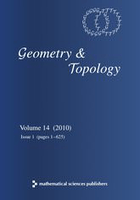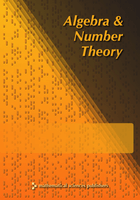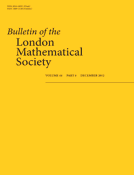
TRANSFORMATION GROUPS
Scope & Guideline
Navigating the Complexities of Algebraic and Geometric Transformations
Introduction
Aims and Scopes
- Algebraic Groups and Their Actions:
This area encompasses the study of algebraic groups and their representations, particularly focusing on their actions on various algebraic varieties and geometric structures. - Geometric Representation Theory:
Research in this scope involves exploring the interplay between geometry and representation theory, including the study of character varieties, moduli spaces, and invariant theory. - Symplectic Geometry and Lie Theory:
Publications often delve into symplectic geometry's connections with Lie groups and algebras, investigating the geometric structures arising from these algebraic systems. - Topological and Differential Aspects of Groups:
This focuses on the topological and differential structures related to transformation groups, including studies on homogeneous spaces and geometric structures on manifolds. - Categorical Approaches in Algebra and Geometry:
The journal features work that employs categorical methods to address problems in algebraic geometry and representation theory, including derived categories and functorial perspectives.
Trending and Emerging
- Quantum Groups and Noncommutative Geometry:
Recent publications have increasingly focused on quantum groups and their applications in noncommutative geometry, reflecting a growing interest in understanding symmetries in a quantum context. - Homogeneous Spaces and Their Applications:
There is a rising trend in exploring homogeneous spaces, particularly in relation to their applications in modern geometry, physics, and representation theory. - Geometric Structures in Algebraic Geometry:
The intersection of geometric structures with algebraic geometry is gaining momentum, with researchers investigating how transformation groups can illuminate properties of algebraic varieties. - Derived Categories and Homological Methods:
Emerging themes include the use of derived categories and homological techniques in the study of transformation groups, indicating a shift towards more abstract and categorical frameworks.
Declining or Waning
- Classical Symmetry Methods:
Research focusing on classical symmetry methods in geometry has decreased, as newer approaches and technologies in computational mathematics provide alternative pathways for exploration. - Elementary Group Theory:
There has been a reduction in papers centered on basic group theory concepts, possibly due to a shift towards more complex and abstract formulations that integrate various mathematical disciplines. - Topological Groups without Algebraic Structure:
Works involving purely topological groups that lack a significant algebraic structure have become less frequent, as the focus has shifted towards groups with richer algebraic properties.
Similar Journals

MANUSCRIPTA MATHEMATICA
Connecting Scholars through Rigorous Peer Review.MANUSCRIPTA MATHEMATICA is an esteemed journal in the field of mathematics, published by Springer Heidelberg. Since its inception in 1969, this journal has served as a pivotal platform for disseminating high-quality research in a variety of mathematical disciplines, with a commitment to advancing knowledge and fostering collaboration among mathematicians. The journal holds a commendable impact factor and is ranked within the Q2 category for Mathematics (miscellaneous) in 2023, placing it favorably among its peers in terms of academic influence. Although open access options are not available, its rigorous peer-review process ensures that published articles maintain the highest academic standards. With a wide scope covering significant areas of general mathematics, MANUSCRIPTA MATHEMATICA not only caters to researchers and professionals seeking innovative insights but also serves as a valuable resource for students eager to deepen their understanding of mathematical theories and applications. For those looking to contribute to or stay informed about advancements in this dynamic field, the journal remains a crucial resource for literature and discourse.

JOURNAL OF DIFFERENTIAL GEOMETRY
Fostering breakthroughs in geometry and analysis.JOURNAL OF DIFFERENTIAL GEOMETRY, a premier publication by INT PRESS BOSTON, INC, has established itself as a leading forum for the dissemination of high-quality research in the fields of differential geometry, algebra, and analysis. With an impressive history that spans from 1967 to 2024, this journal is recognized for its rigorous peer-reviewed articles, contributing significantly to the advancement of mathematical theories and innovative approaches. Notably, the journal boasts a Q1 ranking in key categories such as Algebra and Number Theory, Geometry and Topology, and Analysis, reflecting its pivotal role within the mathematics community. Its Scopus rankings reinforce its reputation, placing it among the top-tier journals in its respective fields, with a 97th percentile ranking in Algebra and Number Theory, further emphasizing its influence. While the journal does not offer Open Access options, it remains a critical resource for researchers, professionals, and students aiming to stay at the forefront of developments in differential geometry and related domains. Engage with groundbreaking research and explore new methodologies that are shaping the future of mathematics.

GEOMETRY & TOPOLOGY
Unraveling the Intricacies of Space and ShapeGeometry & Topology is a leading journal in the field of mathematics, focusing on the intricate relationships between geometric structures and topological spaces. Published by Geometry & Topology Publications in the United Kingdom, this prestigious journal boasts an impressive ranking, placing it in the Q1 quartile for Geometry and Topology as of 2023, with a notable Scopus rank of #13 out of 106, indicating its significant impact within the discipline (88th percentile). With publication years spanning from 1997 to 2024, the journal serves as a vital platform for disseminating high-quality research, fostering advances in both theoretical and applied aspects of the field. While it does not currently operate under an Open Access model, it nevertheless attracts the attention of a diverse audience, including researchers, academics, and students eager to explore innovative methodologies and findings in geometry and topology. The journal’s commitment to excellence makes it an essential resource for anyone passionate about mathematical research.

Journal of Homotopy and Related Structures
Connecting Mathematicians Through Scholarly ExchangeJournal of Homotopy and Related Structures is a distinguished academic journal published by Springer Heidelberg, specializing in the fields of algebra, number theory, geometry, and topology. With a focus on the intricate relationships and structures within these disciplines, the journal aims to facilitate the dissemination of original research and provide a platform for scholarly exchange among mathematicians. Since its inception in 2012, the journal has positioned itself in the Q2 category for both Algebra and Number Theory and Geometry and Topology in 2023, reflecting its growing influence and commitment to high-quality publications. Although it operates under a subscription model, the research published in this journal is highly cited, contributing to its notable rankings—#57 in Geometry and Topology and #65 in Algebra and Number Theory on the Scopus index. This journal is an essential resource for researchers, professionals, and students who wish to stay updated with the latest advancements and trends in homotopy theory and related mathematical structures.

Forum of Mathematics Sigma
Advancing mathematical frontiers for a global audience.Forum of Mathematics Sigma is a premier open access journal published by Cambridge University Press that has been at the forefront of mathematical research since its inception in 2013. With a strong emphasis on advancing the fields of mathematics, the journal consistently achieves Q1 rankings across multiple categories, including Algebra and Number Theory, Analysis, and Computational Mathematics. This distinction highlights its impact and relevance within the scholarly community. The journal prides itself on providing a platform for innovative research, fostering collaboration among researchers and practitioners across various mathematical disciplines. Open access publication ensures that cutting-edge findings are widely available to readers globally, enhancing the dissemination of knowledge. With an address in the heart of Cambridge, England, Forum of Mathematics Sigma is dedicated to promoting high-quality research and making significant contributions to the development of mathematics.

Algebra & Number Theory
Unveiling New Horizons in Mathematical ScienceAlgebra & Number Theory, published by Mathematical Science Publications, stands at the forefront of mathematical research, particularly in the fields of algebra and number theory. With an ISSN of 1937-0652 and E-ISSN 1944-7833, this esteemed journal provides a dedicated platform for the dissemination of cutting-edge theoretical advances and practical applications. It has achieved a Q1 category ranking in both algebra and number theory according to the 2023 quartiles, reinforcing its critical role in shaping contemporary mathematical discourse. The journal serves as an essential resource for researchers, professionals, and students alike, offering insights into diverse mathematical methodologies and fostering open dialogue among scholars. Although it does not provide open access, its robust impact factor reflects the high quality and relevance of its published work. Based in the United States at the University of California, Berkeley, the journal's commitment to excellence continues to attract contributions that push the boundaries of mathematical understanding.

Selecta Mathematica-New Series
Elevating Mathematical and Physical Sciences.Selecta Mathematica-New Series is a premier academic journal published by Springer International Publishing AG, based in Switzerland. With an impressive impact in the fields of Mathematics and Physics, it is recognized in the Q1 category for both Mathematics (Miscellaneous) and Physics and Astronomy (Miscellaneous) as of 2023. Established in 1995, the journal provides a platform for rigorous peer-reviewed research, facilitating the dissemination of groundbreaking findings and theoretical advancements through its converged publication years up to 2024. Researchers and scholars seeking to stay at the forefront of mathematical and physical sciences will benefit from the journal's diverse scope and high-impact articles. Although it does not operate under an open-access model, Selecta Mathematica-New Series remains a vital resource for building knowledge and fostering collaboration among professionals and students engaged in these dynamic fields. Access to its content is essential for those aiming to deepen their understanding and contribute to the ongoing dialogue within the scientific community.

BULLETIN OF THE LONDON MATHEMATICAL SOCIETY
Connecting Scholars Through Mathematical ExcellenceThe BULLETIN OF THE LONDON MATHEMATICAL SOCIETY, published by Wiley, is a distinguished journal that serves as a vital resource in the field of mathematics. With its ISSN 0024-6093 and E-ISSN 1469-2120, this journal has consistently provided a platform for innovative research and scholarly discourse since its inception in 1969. Recognized for its quality, it currently holds an impressive Q1 ranking in the mathematics category, a testament to its significance in disseminating influential findings and trends in the mathematical sciences. Researchers and practitioners can rely on the BULLETIN for its comprehensive coverage of both theoretical and applied mathematics, which caters to a diverse audience ranging from professionals to students alike. Though it does not currently offer Open Access options, its articles can be accessed through institutional subscriptions, ensuring that significant works reach the academic community effectively. With contributions that span over five decades, the journal continues to shape mathematical research and inspire future advancements in the discipline.

Cambridge Journal of Mathematics
Empowering Researchers with Cutting-Edge InsightsCambridge Journal of Mathematics, published by INT PRESS BOSTON, INC, is a premier platform for the dissemination of cutting-edge research in the field of mathematics. With an ISSN of 2168-0930 and E-ISSN 2168-0949, this journal stands out in a competitive academic landscape, currently ranked #58 out of 399 in General Mathematics, placing it in the top 15% within its category according to Scopus metrics. The journal serves as a vital resource for researchers, professionals, and students alike, aiming to foster groundbreaking mathematical inquiries and foster collaboration across disciplines. Published from 2020 to 2024, the Cambridge Journal of Mathematics is committed to maintaining high standards of scholarship, making it an essential read for those who are passionate about advancing mathematical knowledge and its applications.

Algebraic Geometry
Fostering Innovation in Algebraic Geometry Since 2014Algebraic Geometry, published by the European Mathematical Society, stands as a pivotal platform in the realm of modern mathematics, focusing on the intricate interplay between algebra and geometry. Since its inception in 2014, this Open Access journal has garnered significant attention, reflected in its prestigious rankings, including Q1 status in the categories of Algebra and Number Theory and Geometry and Topology, as per the 2023 metrics. With an impressive Scopus ranking of #18/119 in Algebra and Number Theory and #18/106 in Geometry and Topology, it ensures high visibility and accessibility of groundbreaking research. Based in Germany, at the esteemed Technical University of Berlin, the journal serves as a beacon for researchers, professionals, and students aiming to push the boundaries of knowledge in these dynamic fields. The scope of the journal encompasses diverse topics, including but not limited to, the latest developments in algebraic structures and geometric configurations, promising to enrich the academic discourse and foster innovation. As we converge towards its tenth anniversary in 2024, Algebraic Geometry continues to evolve and solidify its role as an essential resource for the mathematical community.